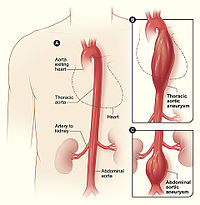
Photo from wikipedia
Objective: We performed a systematic review and meta‐analysis aiming to assess the mortality and morbidity of all published case series on thoracoabdominal aortic aneurysms (TAAAs) in experienced centers treated with… Click to show full abstract
Objective: We performed a systematic review and meta‐analysis aiming to assess the mortality and morbidity of all published case series on thoracoabdominal aortic aneurysms (TAAAs) in experienced centers treated with open repair. Methods: A systematic search of the literature published until April 2017 was performed according to the Preferred Reporting Items for Systematic Reviews and Meta‐Analyses guidelines. Separate meta‐analyses were conducted for overall in‐hospital mortality for TAAA, mortality according to the type of TAAA, spinal cord ischemia, paraplegia and paraparesis, cardiac events, stroke, acute kidney failure, and bowel ischemia. A metaregression analysis was performed with volume of the center, percentage of ruptured cases among the series, length of in‐hospital stay, and publication year as covariates. Results: A total of 30 articles were included in the meta‐analysis, corresponding to a total of 9963 patients who underwent open repair for TAAAs (543 ruptured). The pooled mortality rate among all studies was 11.26% (95% confidence interval [CI], 9.56‐13.09). Mortality was 6.97% (95% CI, 3.75‐10.90), 10.32% (95% CI, 7.39‐13.63), 8.02% (95% CI, 6.37‐9.81), and 7.20% (95% CI, 4.19‐10.84) for Crawford types I, II, III, and IV, respectively. Pooled spinal cord ischemia rate was estimated at 8.26% (95% CI, 6.95‐9.67), whereas paraparesis and paraplegia rates were 3.61% (95% CI, 2.25‐5.25) and 5% (95% CI, 4.36‐5.68), respectively. We estimated a pooled cardiac event rate of 4.41% (95% CI, 1.84‐7.95) and a stroke rate of 3.11% (95% CI, 2.36‐3.94), whereas the need for permanent dialysis rate was 7.92% (95% CI, 5.34‐10.92). Respiratory complications after surgery were as high as 23.01% (95% CI, 14.73‐32.49). Metaregression analysis evidenced a statistically significant inverse association between mortality and the volume of cases performed in the vascular center (t = −2.00; P = .005). Interestingly, a more recent year of study publication tended to be associated with decreased in‐hospital mortality (t = −1.35; P = .19). Conclusions: Our study showed that despite the advances in open surgical techniques, the morbidity and mortality of the technique continue to remain considerable. Despite the focus on mortality and spinal cord ischemia, respiratory complications, permanent postoperative renal dialysis, stroke rate, and cardiac events also affect the outcome. The estimated trend of lower mortality in high‐volume centers suggests that perhaps this type of service should be provided in a few reference centers that have an established record and experience in the management of these patients.
Journal Title: Journal of Vascular Surgery
Year Published: 2018
Link to full text (if available)
Share on Social Media: Sign Up to like & get
recommendations!